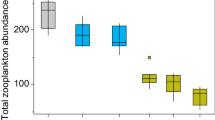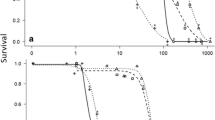Abstract
Application of the organophosphorus insecticide temephos to a natural pond in central Minnesota was followed by reduction within 24 hr in all cladocerans, inDiaptomus leptopus and inChaoborus americanus, and increases in cyclopoid copepods, copepod nauplii and the rotiferKeratella cochlearis. Daphnia pulex that reappeared 35 days post-application were ex-ephippial. After application, reproduction of cladocerans andDiaptomus was markedly reduced compared to the previous year, an effect attributed to temephos.Daphnia population density was strongly reduced into the fall season, long after the spring applications, compared with both a reference pond's and the previous season's populations. On-site bioassays demonstrated 24-hr mortalities ofDaphnia andChaoborus that were comparable to the population decreases in the pond. Laboratory toxicity tests showedDaphnia was the most sensitive followed byChaoborus andDiaptomus. Comparable results were seen in the pond population changes,in situ bioassays and laboratory toxicity data forDaphnia and forChaoborus, but sensitivities in the pond were somewhat greater than in the laboratory. Risk assessment research calls for long-term field reproduction analysis to avoid a false “recovery” report, combined with laboratory life cycle analysis and short acute exposure tests.
Similar content being viewed by others
References
Ali A, Mulla MS (1980) Activity of organophosphate and synthetic pyrethroid insecticides against pestiferous midges in some Southern California flood control channels. Mosq News 40:593–597
— (1978) Effects of chironomid larvicides and diflubenzuron on nontarget invertebrates in residential-recreational lakes. Environ Entomol 7:21–27
Anderson RL, Shubat P (1984) Toxicity of flucythrinate toGammarus lacustris (Amphipoda)Pteronarcys dorsata (Plecoptera) andBrachycentrus americanus (Trichoptera): Importance of exposure duration. Environ Pollut (Ser A) 35:353–65
Fox HM, Gilchrist B, Phear E (1951) Functions of haemoglobin inDaphnia. Proc Roy Soc London (Ser B) 138:514–528
Frank AM, Sjogren RD (1978) Effect of temephos and chlorpyrifos on Crustacea. Mosq News 38:138–139
Frommer R, Nelson J, Gibbs P, Vorgetts J (1983) Dose-time response betweenSimulium vittatum (Diptera: Simuliidae) larvae and ABATE®200e (temephos). Mosq News 43:71–72
Hairston N (1987) Diapause as a predator avoidance adaptation XVIII. In: Kerfoot WC, Sih A (eds) Predation Direct and Indirect Impacts on Aquatic Communities. University Press of New England, Hanover, pp 281–290
Hairston N, Olds E (1984) Population differences in the timing of diapause: Adaptation in a spatially heterogeneous environment. Oecologia (Berlin) 61:42–48
Helson B, Surgeoner G, Ralley W (1979) Susceptibility ofCulex spp andAedes spp larvae (Diptera: Culicidae) to temephos and chlorphyrifos in southern Ontario. Proc Entomol Soc Ontario 110:79–83
Hughes D, Boyer M, Papst M, Fowle C, Rees G, Baulu P (1980) Persistence of three organophosphorus insecticides in artificial ponds and some biological implications. Arch Environ Contam Toxicol 9:269–279
Kaushnik NK, Stephenson GL, Solomon KR, Day KE (1985) Impact of permethrin on Zooplankton communities in limnocorrals. Can J Fish Aquat Sci 42:77–85
Lynch M (1979) Predation, competition, and Zooplankton community structure: An experimental study. Limnol Oceanogr 24:253–272
Muller R (1970) Laboratory experiments on the control ofCyclops transmitting Guinea worm. Bull World Health Organization 42:563–567
O'Brien R, Winner J, Krochak D (1973) Ecology ofDiaptomus leptopus s a Forbes 1882 (Copepoda: Calanoida) under temporary pond conditions. Hydrobiologia 43:137–155
Papst M, Boyer M (1980) Effects of two organophosphorus insecticides on the chlorophyll and pheopigment concentrations of standing ponds. Hydrobiologia 69:245–250
Rettich R (1979) Laboratory and field investigations in Czechoslovakia with fenitrothion, pirimiphos-methyl, temephos, and other organophosphorous larvicides applied as sprays for control ofCulex pipiens molestus Forskal andAedes cantans Meigen. Mosq News 39:320–328
Ruber E, Baskar J (1968) Sensitivities of selected microcrustacea to eight mosquito toxicants. New Jersey Mosq Exterm Assoc 55:99–103
Sawchyn WW, Hammer UT (1968) Growth and reproduction of someDiaptomus spp in Saskatchewan ponds. Can J Zool 46:511–520
Sailer R, Lienk S (1954) Insect predators of mosquito larvae and pupae in Alaska. Mosq News 14:14–16
Seifert R (1985) Effects of ABATE®(temephos) on non-target aquatic organisms in a natural pond undergoing mosquito control treatment. Progress Report June 1985, US Environmental Protection Agency, Environmental Research Laboratory, Duluth, MN 55804
Vinyard G, Menger R (1980)Chaoborus americanus predation on various zooplankters: functional response and behavioral observations. Oecologia 45:90–93
Watras C (1980) Subitaneous and resting eggs of copepods: Relative rates of clutch production byDiaptomus leptopus. Can J Fish Aquat Sci 37:1579–1581
Whiteside M, Lindegaard D (1980) Complimentary procedures for sampling small benthic invertebrates. Oikos 35:317–320
Zaret TM (1980) Predation and Freshwater Communities. Yale University Press, New Haven, 187 pp
Author information
Authors and Affiliations
Rights and permissions
About this article
Cite this article
Helgen, J.C., Larson, N.J. & Anderson, R.L. Responses of zooplankton andChaoborus to temephos in a natural pond and in the laboratory. Arch. Environ. Contam. Toxicol. 17, 459–471 (1988). https://doi.org/10.1007/BF01055511
Received:
Revised:
Issue Date:
DOI: https://doi.org/10.1007/BF01055511




